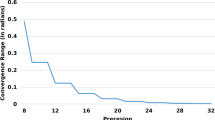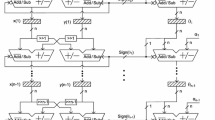Abstract
This paper presents the hardware and delay efficient design of a radix-4 pipelined hyperbolic Coordinate Rotation Digital Computer (CORDIC) architecture. The proposed design uses pre-computation based micro-rotation sequence generation to reduce the cycle time and number of iterations. It also eliminates the need for residue angle computation in every iteration that helps to enhance the operating speed. The methodology finds a linear relation between rotation angle input and micro-rotation sequence by selectively choosing elementary angles from the set of valid angles. Therefore, it requires six clock cycles to compute the hyperbolic functions (cosh/sinh). Further, the region of convergence (ROC) of the proposed design is extended to cover the entire coordinate space. Based on the proposed hyperbolic CORDIC design, a hyperbolic (Direct Digital Synthesis) DDS is implemented using XC7VX330T (Vertex-7 family) field-programmable gate array (FPGA) in Xilinx ISE platform. The proposed design achieves 47% and 37% savings in basic logic elements and number of slices respectively than recent designs. The design also achieves an improved slice delay product of 5.28 and a maximum frequency of operation of 500.75 MHz.














Similar content being viewed by others
Data Availability
No datasets were generated or analysed during the current study.
References
Jridi, M., & Meher, P. (2016). A scalable approximate DCT architecture for efficient HEVC compliant video coding. IEEE Transactions on Circuits and Systems for Video Technology, 27(8), 1815–1825.
Parfieniuk, M., Vashkevich, M., & Petrovsky, A. (2013). Short-critical-path and structurally orthogonal scaled CORDIC-based approximations of the eightpoint discrete cosine transform. IET Circuits, Devices & Systems, 7(3), 150–158.
Maharatna, K., Dhar, A. S., & Banerjee, S. (2001). A VLSI array architecture for realization of DFT, DHT, DCT and DST. Signal Processing, 81, 1813–1822.
Maharatna, K., & Banerjee, S. (2001). A VLSI array architecture for Hough transform. Pattern Recognition, 34(7), 1503–1512.
Meher, P. K., et al. (2009). 50 years of CORDIC: Algorithms, architectures and applications. IEEE Transactions on Circuits and Systems I: Regular Papers, 56(9), 1893–1907.
Juang, T. B., Hsiao, S. F., & Tsai, M. Y. (2004). Para-CORDIC: Parallel CORDIC rotation algorithm. IEEE Transactions on Circuits and Systems I: Regular Papers, 51(8), 1515–1524.
Juang, T. B. (2008). Low latency angle recoding methods for the higher bit-width parallel CORDIC rotator implementations. IEEE Transactions on Circuits and Systems II: Express Briefs, 55(11), 1139–1143.
Rodrigues, T., & Swartzlander, E. E. (2010). Adaptive CORDIC: Using parallel angle recoding to accelerate rotations. IEEE Transactions on Computers, 59(4), 522–531.
Hu, Y. H., & Naganathan, S. (1993). Angle recoding method for efficient implementation of the CORDIC algorithm. IEEE Transactions on Computers, 42, 99–102.
Wu, C.-S., Wu, A.-Y., & Lin, C.-H. (2003). A high performance /low-latency vector rotational CORDIC architecture based on extended elementary angle set and trellis-based searching schemes. IEEE Transactions on Circuits and Systems II: Analog and Digital Signal Processing, 50(9), 589–601.
Srikanthan, T., & Gisuthan, B. (2002). A novel technique for eliminating iterative based computation of polarity of micro-rotations in CORDIC based sinecosine generators. Microprocessors and Microsystems, 26(5), 243–252.
Ravichandran, S., & Asari, V. (2003). Pre-computation of rotation bits in unidirectional CORDIC for trigonometric and hyperbolic computations. IEEE Computer Society Annual Symposium on VLSI, 2003. Proceedings, 215–216.
Hsiao, S. F., Hu, Y. H., & Juang, T. B. (2004). A memory-efficient and high-speed sine/ cosine generator based on parallel CORDIC rotations. IEEE Signal Processing Letters, 11(2), 152–155.
Kuhlmann, M., & Parhi, K. K. (2002). P-CORDIC: A precomputation based rotation CORDIC algorithm. EURASIP Journal on Advances in Signal Processing, 9, 936–943.
Lakshmi, B., & Dhar, A. S. (2013). VLSI architecture for parallel radix-4 CORDIC. Microprocessors and Microsystems, 37(1), 79–86.
Parmar, Y., & Sridharan, K. (2018). Precomputation-based radix-4 CORDIC for approximate rotations and Hough transform. IET Circuits, Devices and Systems, 12(4), 413–423.
Antelo, E., Villalba, J., Bruguera, J. D., et al. (1997). High performance rotation architectures based on the radix-4 CORDIC algorithm. IEEE Transactions on Computers, 46(8), 855–870.
Antelo, E., Lang, T., & Bruguera, J. D. (2000). Very-high radix circular CORDIC: Vectoring and unified rotation/vectoring. IEEE Transactions on Computers, 49(7), 727–739.
Rao, P. R., & Chakrabarti, I. (2002). High-performance compensation technique for the radix-4 CORDIC algorithm. IEE Proceedings-Computers and Digital Techniques, 149(5), 219–228.
Antelo, E., Lang, T., & Bruguera, J. D. (2000). Very-High Radix CORDIC Rotation Based on Selection by Rounding. Journal of VLSI Signal Processing-Systems for Signal, Image, and Video Technology, 25, 141–153.
Villalba, J., Lang, T., & Zapata, E. L. (1998). Parallel compensation of scale factor for the CORDIC algorithm. Journal of VLSI Signal Processing Systems for Signal, Image and Video Technology, 19, 227–241.
Lin, C. H., & Wu, A. Y. (2005). Mixed-Scaling-Rotation-CORDIC (MSRCORDIC) algorithm and architecture for high-performance vector rotational DSP applications. IEEE Transactions on Circuits and Systems I: Regular Papers, 52(11), 2385–2396.
Sumanasena, M. G. B. (2008). A scale factor correction scheme for the CORDIC algorithm. IEEE Transactions on Computers, 57(8), 1148–1152.
Maharatna, K., et al. (2005). Modified virtually scaling-free adaptive CORDIC rotator algorithm and architecture. IEEE Transactions on Circuits and Systems for Video Technology, 11(11), 1463–1474.
Jaime, F., et al. (2010). Enhanced scaling-free CORDIC. IEEE Transactions on Circuits and Systems I: Regular Papers, 57(7), 1654–1662.
Aggarwal, S., Meher, P. K., & Khare, K. (2012). Area-time efficient scaling free CORDIC using generalized micro-rotation selection. IEEE Transactions on Very Large Scale Integration (VLSI) Systems, 20(8), 1542–1546.
Aggarwal, S., Meher, P. K., & Khare, K. (2013). Scale-free hyperbolic CORDIC processor and its application to waveform generation. IEEE Transactions on Circuits and Systems I: Regular Papers, 60(2), 314–326.
Gisuthan, B., & Srikanthan, T. (2000). Flat CORDIC: A unified architecture for high-speed generation of trigonometric and hyperbolic functions. Proceedings of the 43rd IEEE Midwest Symposium on Circuits and Systems, 3, 1414–1417.
Llamocca-Obregón, D. R., & Agurto-Ríos, C. P. (2007). A fixed-point implementation of the expanded hyperbolic CORDIC algorithm. Latin American Applied Research, 37(1), 83–91.
Aggarwal, S., Meher, P. K., & Khare, K. (2016). Concept, Design and Implementation of Reconfigurable CORDIC. IEEE Transactions on Very Large Scale Integration (VLSI) Systems, 24(4), 1588–1592.
Aggarwal, S., & Khare, K. (2013). Leading One Detection Hyperbolic CORDIC with Enhanced Range of Convergence. Journal of Signal Processing Systems, 70, 49–57.
Chakraborty, M., Pervin, S., & Lamba, T. N. (2001). A hyperbolic LMS algorithm for CORDIC based realization. Proceedings of the 11th IEEE Signal Processing Workshop on Statistical Signal Processing, 373–376.
Lang, T., & Antelo, E. (2005). High-throughput CORDIC-based geometry operations for 3D computer graphics. IEEE Transactions on Computers, 54(3), 347–361.
Mopuri, S., & Acharyya, A. (2020). Configurable rotation matrix of hyperbolic CORDIC for any logarithm and its inverse computation. Circuits, Systems, and Signal Processing, 39, 2551–2573.
Author information
Authors and Affiliations
Corresponding author
Ethics declarations
Competing Interests
The authors declare no conflict of interests directly or indirectly related to work.
Additional information
Publisher's Note
Springer Nature remains neutral with regard to jurisdictional claims in published maps and institutional affiliations.
Rights and permissions
Springer Nature or its licensor (e.g. a society or other partner) holds exclusive rights to this article under a publishing agreement with the author(s) or other rightsholder(s); author self-archiving of the accepted manuscript version of this article is solely governed by the terms of such publishing agreement and applicable law.
About this article
Cite this article
Pujari, S.S., Bhaskar, M. Design and FPGA Implementation of Pre-computation Based Radix-4 Hyperbolic CORDIC for Direct Digital Synthesis. J Sign Process Syst 95, 765–775 (2023). https://doi.org/10.1007/s11265-023-01879-3
Received:
Revised:
Accepted:
Published:
Issue Date:
DOI: https://doi.org/10.1007/s11265-023-01879-3




